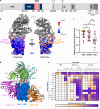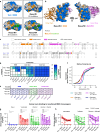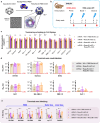Design of SARS-CoV-2 RBD immunogens to focus immune responses toward conserved coronavirus epitopes
- PMID: 40511920
- PMCID: PMC12282168
- DOI: 10.1128/jvi.00465-25
Design of SARS-CoV-2 RBD immunogens to focus immune responses toward conserved coronavirus epitopes
Abstract
SARS-CoV-2 continues to evolve, with new variants emerging that evade pre-existing immunity and limit the efficacy of existing vaccines. One approach toward developing superior, variant-proof vaccines is to engineer immunogens that preferentially elicit antibodies with broad cross-reactivity against SARS-CoV-2 and its variants by targeting conserved epitopes on spike. The inner and outer faces of the receptor binding domain (RBD) are two such conserved regions targeted by antibodies that recognize diverse human and animal coronaviruses. To promote the elicitation of such antibodies by vaccination, we engineered "resurfaced" RBD immunogens that contained mutations at exposed RBD residues outside the target epitopes. In the context of pre-existing immunity, these vaccine candidates aim to disfavor the elicitation of strain-specific antibodies against the immunodominant receptor binding motif (RBM) while boosting the induction of inner and outer face antibodies. The engineered resurfaced RBD immunogens were stable, lacked binding to monoclonal antibodies with limited breadth, and maintained strong interactions with target broadly neutralizing antibodies. When used as vaccines, they limited humoral responses against the RBM as intended. Multimerization on nanoparticles further increased the immunogenicity of the resurfaced RBD immunogens, thus supporting resurfacing as a promising immunogen design approach to rationally shift natural immune responses to develop more protective vaccines.IMPORTANCESARS-CoV-2 is the third coronavirus to cause significant human disease over the last two decades. Despite their success in preventing serious disease, current SARS-CoV-2 vaccines must be updated regularly to match the circulating strains for continued protection. Therefore, it would be advantageous to develop vaccines that protect more broadly against SARS-CoV-2, its variants, and other pre-emergent coronaviruses. This may be achieved by preferentially eliciting antibodies against conserved regions of the spike protein that decorates the virus. Toward this goal, we engineered vaccine candidates to target the conserved inner and outer domains of the Receptor Binding Domain of SARS-CoV-2, by altering the surface of the wild-type protein such that strain-specific antibodies that bind outside these regions are no longer recognized. When used in animals with pre-existing SARS-CoV-2 immunity, these molecules reduce the elicitation of variant-specific antibodies, thus providing a blueprint to alter the natural immunodominance hierarchies of SARS-CoV-2 proteins.
Keywords: RBD; SARS-CoV-2 vaccines; immunogen design; vaccine design.
Conflict of interest statement
The authors declare no conflict of interest.
Figures




Update of
-
Design of SARS-CoV-2 RBD Immunogens to Focus Immune Responses Towards Conserved Coronavirus Epitopes.bioRxiv [Preprint]. 2025 Jan 10:2025.01.09.632180. doi: 10.1101/2025.01.09.632180. bioRxiv. 2025. Update in: J Virol. 2025 Jul 22;99(7):e0046525. doi: 10.1128/jvi.00465-25. PMID: 39829739 Free PMC article. Updated. Preprint.
References
MeSH terms
Substances
Grants and funding
LinkOut - more resources
Full Text Sources
Medical
Miscellaneous

